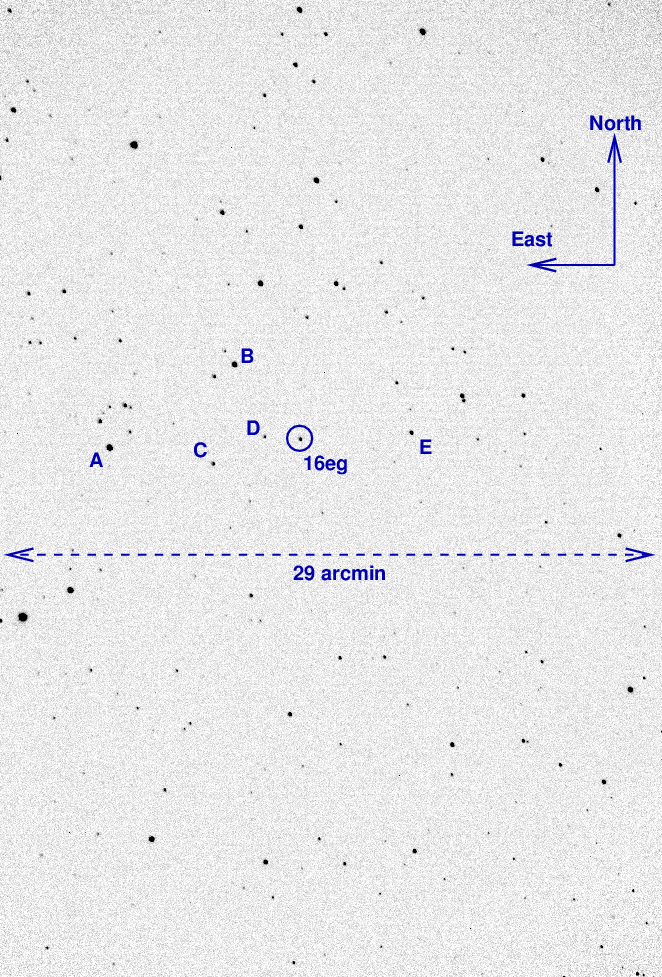
On the night of Apr 12/13, 2016, Jen Connelly, Kaitlin Schmidt, and I continued to test the new ATIK CCD camera with its filterwheel on the telescope. The conditions were good, and we were able to acquire a good, long run of observations of the cataclysmic variable star ASASSN-16eg.
The main setup was:
This cataclysmic variable star was noticed by the ASASSN search recently. Tonny Vanmunster acquired an early set of observations and announced that it was a particularly interesting system:
Tonight (2016, Apr 10/11), I have been running an unfiltered CCD photometry session of ASASSN-16eg at CBA Belgium Observatory, using a 0.35-m f/6.3 telescope and STT-3200ME CCD camera, under clear skies. The resulting light curve clearly shows the presence of double-waved early superhumps. This establishes this target as a new WZ Sge-type dwarf nova. The amplitude is approx 0.15 mag. A preliminary period analysis using the ANOVA, Lafler-Kinman and PDM methods (Peranso), yields a combined period of 0.0736 +/- 0.0007d (106 min). The object is currently bright at mag 12.7 (unfiltered).
The object is located at
RA = 17:26:10.36 Dec = 42:20:02.7
A chart of the field is shown below. The size of the chart is about 44 arcmin tall (North-South) and 29 arcmin wide (East-West). This rather unusual portrait-mode orientation is forced on us if we use the off-axis guider on the new ATIK 11000 camera.

Entries for some of the marked comparison stars from the UCAC4 follow:
star UCAC4 B V ---------------------------------------------------- A 662-062549 11.569 10.476 B 662-062523 11.434 10.970 C 662-062528 13.831 13.170 D 662-062515 14.533 13.817 ----------------------------------------------------
I used 40-second exposures in V-band. The signal-to-noise is a bit lower than I'd like, so in the future, I might try unfiltered measurements.
Conditions were pretty good. The quarter moon set early in the run, and the skies were dark. Measurements of the sky background value show a smooth decrease as the field rose, until dawn came. No clouds!
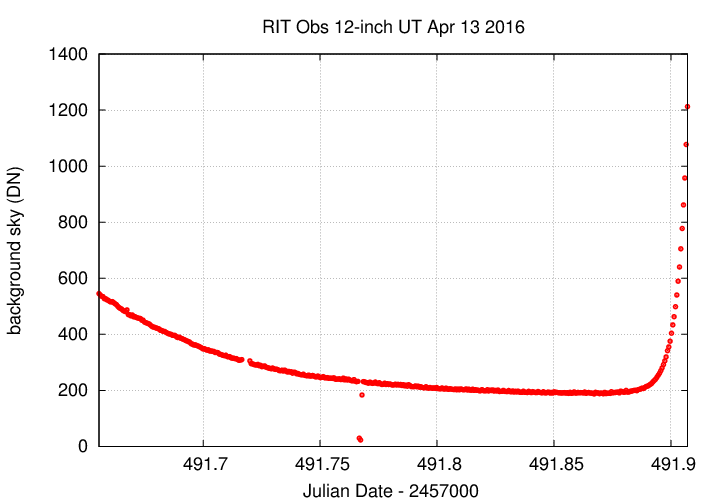
The FWHM was relatively steady at about 4 pixels. However, the images were _not_ in good focus: I could see a slightly comatic shape to stellar traces. I wonder if the V-band filter may be slightly tilted in the filterwheel.
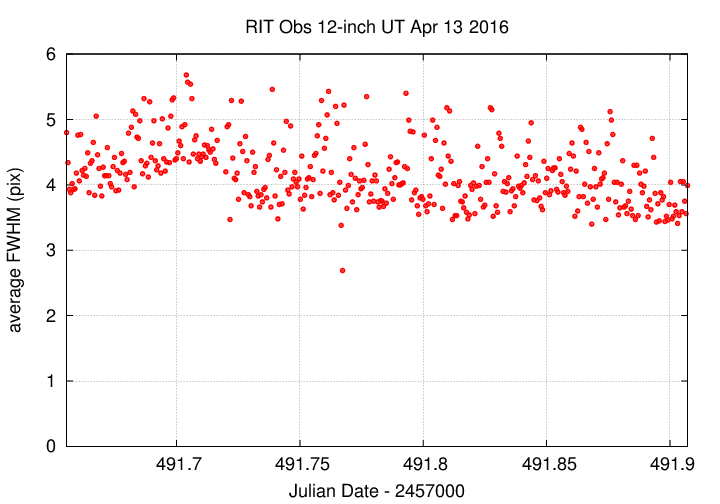
The lack of guider really hurt, as stars drifted across the chip. I tried to make manual corrections every 10 minutes or so to keep stars in roughly the same position on the detector, but some of the scatter in the final measurements must be due to variations as sources moved from one region to another.
This camera shows strong vignetting, so I removed any measurements which were made more than 600 pixels (791 arcsec = 13.2 arcmin) from the center of the field. That helped remove one source of photometric error, and did decrease the overall noise in the photometry of comparison stars.
Using aperture photometry with a radius of 5 pixels (radius of 6.7 arcsec), I measured the instrumental magnitudes of a number of reference stars and the target. Following the procedures outlined by Kent Honeycutt's article on inhomogeneous ensemble photometry, I used all stars available in each image to define a reference frame, and measured each star against this frame.
Sigma-vs-mag plots show that the floor was about 0.006 mag. Not great, but not terrible. ASASSN-16eg is the outlier at diff mag = 2.6.
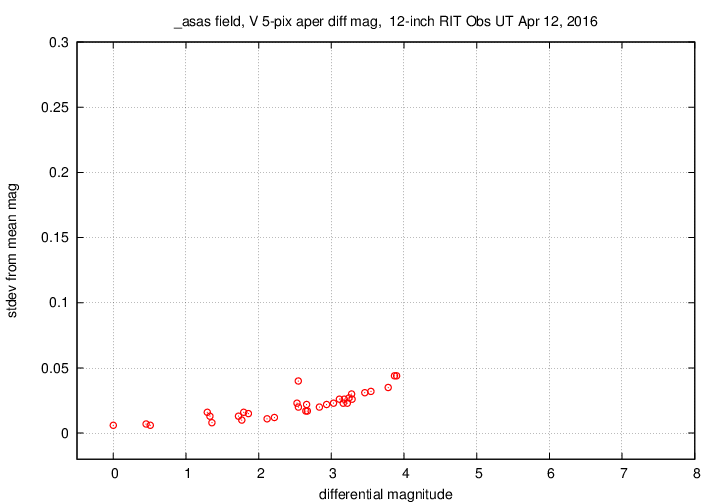
Image adjustment factor shows a big jump, caused by my re-focusing, about halfway through the run. Otherwise, no significant trends or rises due to clouds. The outliers here are due to tracking errors.
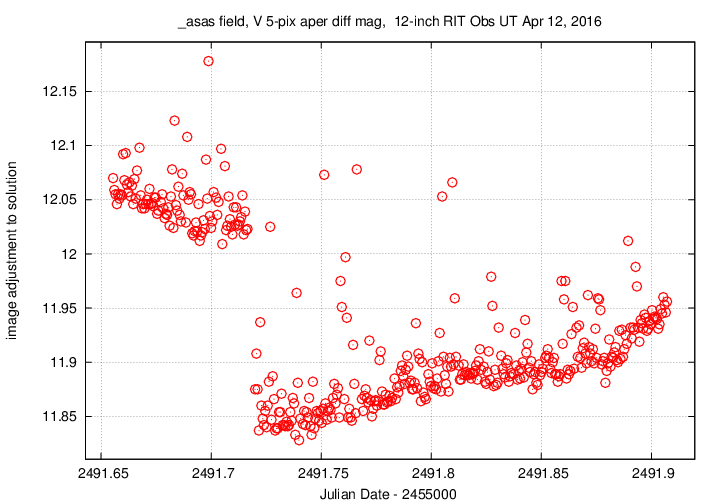
Here are light curves of the variable and the field stars:
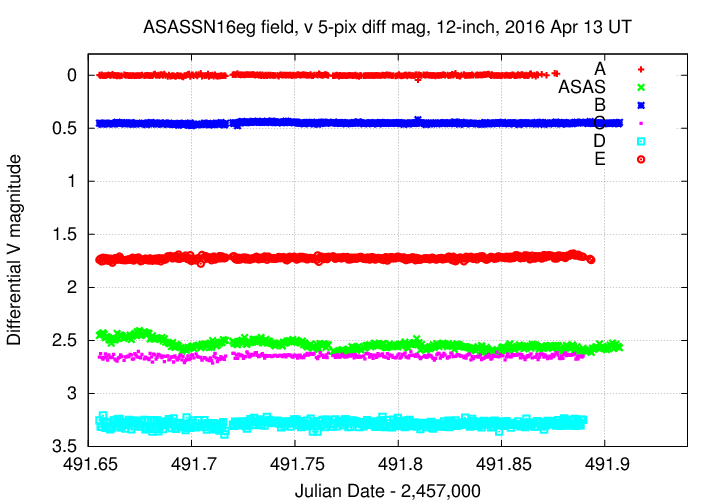
A closeup shows the variations in ASASSN-16eg more clearly.
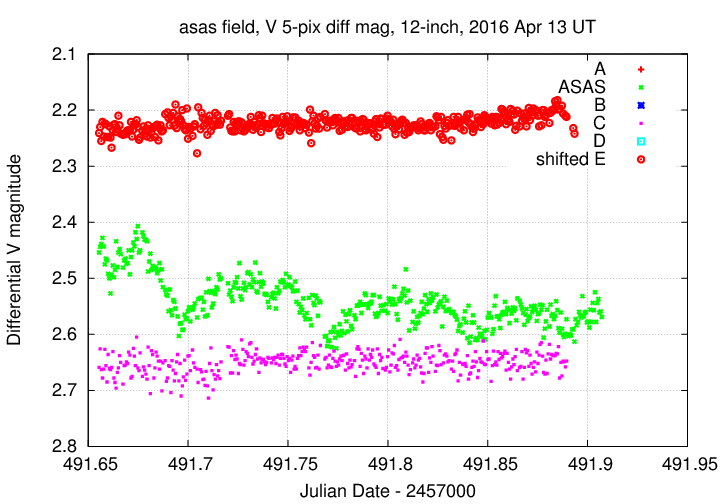
I used the UCAC value for the V-band magnitude of star "C" = UCAC4 662-062528 to shift the ensemble magnitudes to the standard V-band scale. You can download my measurements below. A copy of the header of the file is shown to explain the format.
# Measurements of ASAS_SN16eg made at RIT Obs, Apr 13, 2014 UT, # in good conditions. # by Michael Richmond, using 12-inch Meade and ATIK 11000 CCD. # Exposures 40 seconds long, V filter. # Tabulated times are midexposure (FITS header time - half exposure length) # and accurate only to +/- 1 second (??). # 'mag' is a differential magnitude based on ensemble photometry # using a circular aperture of radius 6.6 arcseconds. # which has been shifted so UCAC4 662-062528 has mag=13.170 # which is its V-band mag according to UCAC4. # # UT_day JD HJD mag uncert Apr13.15544 2457491.65544 2457491.65695 12.975 0.019 Apr13.15601 2457491.65601 2457491.65752 12.965 0.019 Apr13.15657 2457491.65657 2457491.65808 12.960 0.019
Last modified 4/14/2016 by MWR.